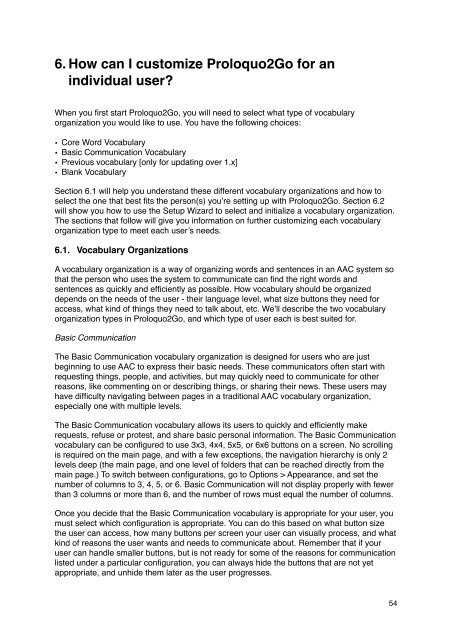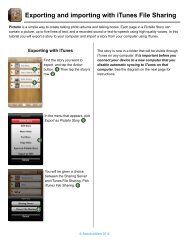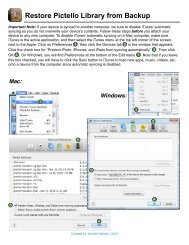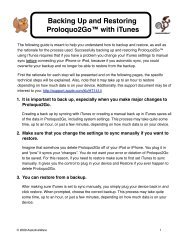Proloquo2Go Manual 2.3_Nov_23 - AssistiveWare
Proloquo2Go Manual 2.3_Nov_23 - AssistiveWare
Proloquo2Go Manual 2.3_Nov_23 - AssistiveWare
Create successful ePaper yourself
Turn your PDF publications into a flip-book with our unique Google optimized e-Paper software.
6. How can I customize <strong>Proloquo2Go</strong> for an<br />
individual user?<br />
When you first start <strong>Proloquo2Go</strong>, you will need to select what type of vocabulary<br />
organization you would like to use. You have the following choices:<br />
• Core Word Vocabulary<br />
• Basic Communication Vocabulary<br />
• Previous vocabulary [only for updating over 1.x]<br />
• Blank Vocabulary<br />
Section 6.1 will help you understand these different vocabulary organizations and how to<br />
select the one that best fits the person(s) you’re setting up with <strong>Proloquo2Go</strong>. Section 6.2<br />
will show you how to use the Setup Wizard to select and initialize a vocabulary organization.<br />
The sections that follow will give you information on further customizing each vocabulary<br />
organization type to meet each user’s needs.<br />
6.1. Vocabulary Organizations<br />
A vocabulary organization is a way of organizing words and sentences in an AAC system so<br />
that the person who uses the system to communicate can find the right words and<br />
sentences as quickly and efficiently as possible. How vocabulary should be organized<br />
depends on the needs of the user - their language level, what size buttons they need for<br />
access, what kind of things they need to talk about, etc. We’ll describe the two vocabulary<br />
organization types in <strong>Proloquo2Go</strong>, and which type of user each is best suited for.<br />
Basic Communication<br />
The Basic Communication vocabulary organization is designed for users who are just<br />
beginning to use AAC to express their basic needs. These communicators often start with<br />
requesting things, people, and activities, but may quickly need to communicate for other<br />
reasons, like commenting on or describing things, or sharing their news. These users may<br />
have difficulty navigating between pages in a traditional AAC vocabulary organization,<br />
especially one with multiple levels.<br />
The Basic Communication vocabulary allows its users to quickly and efficiently make<br />
requests, refuse or protest, and share basic personal information. The Basic Communication<br />
vocabulary can be configured to use 3x3, 4x4, 5x5, or 6x6 buttons on a screen. No scrolling<br />
is required on the main page, and with a few exceptions, the navigation hierarchy is only 2<br />
levels deep (the main page, and one level of folders that can be reached directly from the<br />
main page.) To switch between configurations, go to Options > Appearance, and set the<br />
number of columns to 3, 4, 5, or 6. Basic Communication will not display properly with fewer<br />
than 3 columns or more than 6, and the number of rows must equal the number of columns.<br />
Once you decide that the Basic Communication vocabulary is appropriate for your user, you<br />
must select which configuration is appropriate. You can do this based on what button size<br />
the user can access, how many buttons per screen your user can visually process, and what<br />
kind of reasons the user wants and needs to communicate about. Remember that if your<br />
user can handle smaller buttons, but is not ready for some of the reasons for communication<br />
listed under a particular configuration, you can always hide the buttons that are not yet<br />
appropriate, and unhide them later as the user progresses.<br />
54






